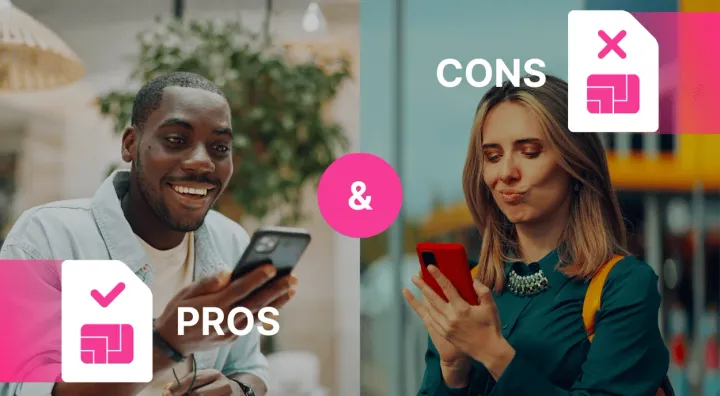Why (and How) to Get a Japanese Phone Number

Japan is one of the easiest countries to travel in when it comes to trains, convenience stores, and even cashless payments. But when it comes to mobile service, things can get surprisingly complicated, especially for foreigners.
Contracts are written in Japanese, many carriers require residency, and even the prepaid options often leave you without one thing you’ll quickly realize you need: a real Japanese phone number. That number will unlock everyday essentials in Japan, from booking restaurants to using delivery apps to gaining trust with landlords or service providers if you’re staying longer.
In this guide, I’ll break down the options for getting a Japanese number as a foreigner, explain why most of the “official” routes don’t work for short-term travelers or nomads, and show you the solution that worked for me: Mobal’s Japan eSIM, which easily gives you both reliable data and a proper local number.
Why Having a Japanese Phone Number Matters
When I first arrived in Japan as a digital nomad, I thought I could get by just fine with WiFi and data on a Japan eSIM. And technically, you can. But after a few days, I already started running into small but annoying roadblocks.
For example, restaurants often wanted a local number to confirm reservations. Same with apps like Uber Eats, Amazon Japan, and even local supermarket delivery services. When I tried signing up, they wouldn’t accept my foreign number. A few times, I was blocked entirely by SMS verification, and my number simply didn’t pass.
Then there are the everyday things you don’t think about until you need them, like giving a number to a taxi driver, filling out travel insurance forms, or making a doctor’s appointment. And if you’re staying more than a couple of months, landlords, employers, and even utility providers take you way more seriously if you can hand over a Japanese number instead of something foreign.
So while you can survive without it, having a local number just makes life in Japan smoother and, honestly, a lot less stressful.
How to Get a Japanese Number as a Foreigner
When I first started looking into getting a Japanese number, I realized pretty quickly that most of the “official” options weren’t made with short-term travelers or digital nomads in mind. Here’s what I found:
Physical SIMs from Japanese carriers
You can go the traditional route with a physical SIM card from the big carriers (docomo or SoftBank), but it usually comes with contracts, Japanese-only paperwork, and the kind of red tape that makes your head spin. Not exactly ideal if you’re only here for a few months.
Prepaid SIMs
Travel SIMs are easy to find at airports, convenience stores, and online. The problem is most of them are data-only. That means you can use Google Maps or join a Zoom call, but you’ll hit a wall when Uber Eats, Amazon Japan, or a delivery service asks for an SMS code from a 070/080/090 number.
Prepaid phones
Yes, you can still buy a prepaid phone, but they’re pricey, old-school, and not flexible at all. For a digital nomad who moves around, carrying a second device just for a Japanese number feels unnecessary.
Pocket WiFi or rental phones
I also tried the “just rent a device” route. Pocket Wi-Fi is convenient if you’re in a group, but it still won’t give you a Japanese phone number. Plus, carrying and charging another device quickly becomes annoying. And you’ll need to return the unit before leaving Japan, which adds another layer of hassle.
eSIMs with a Japanese number
This is the solution that worked best for me. Most international eSIMs give you data but no local number. But services like Mobal’s Japan eSIM actually include a real Japanese number (070/080/090), meaning you can receive verification codes, confirm reservations, and even hand over a number to a landlord or doctor if needed. The setup is online, the ID verification is quick, and there’s no long-term contract. For nomads, it’s easily the most practical option.
Since Mobal was the one I ended up going with, I’ll break down how the Mobal Japan eSIM actually works, from setup to pricing to real-world performance.
The Easiest Way: Mobal Japan eSIM
After weighing all the messy options, Mobal was the one that actually worked for me. Unlike most travel eSIMs that only give you data, Mobal gives you the full deal: data plus a real Japanese number (070/080/090). That one detail alone made my life so much easier for things like booking tables, getting deliveries, and signing up for local apps.
Mobal has been around since 1989 and has served over half a million customers, so it’s not some new player. The company was built by English speakers living in Japan who know exactly what foreigners struggle with when trying to get connected here, and they designed Mobal to cut through all that red tape.
Coverage was rock solid everywhere I went, including Tokyo, Kyoto, Fukuoka, and even smaller towns in between. Because Mobal is a true Japanese eSIM, running on the country’s biggest networks (Docomo and SoftBank), I didn’t have to deal with patchy signal or random slowdowns like I’ve had with global eSIMs in the past.
And here’s something else I found useful: if you already have a data-only eSIM and just need a Japanese number for calls or texts, Mobal offers a separate Voice Lite eSIM. As long as your phone supports dual eSIM, you can simply add it on and solve the “local number” problem without messing with your existing plan.
Mobal Voice + Data Plans and Pricing
Mobal’s eSIM option that gives you data plus a real Japanese number is called the Voice + Data plan.
They are monthly packages starting at just $6.73 for 500 MB and scale up depending on how much data you need: 5 GB, 10 GB, or even 30 GB. There’s a one-time setup fee of about $20.20, but the first month is pro-rated, so you only pay for the days you actually use.
| Plan Type | Data | Price (Monthly) |
|---|---|---|
| Voice + Data | 500 MB | ¥990 (~US $6.73) |
| 1 GB | ¥1,650 (~US $11.22) | |
| 5 GB | ¥3,190 (~US $21.69) | |
| 10 GB | ¥3,630 (~US $24.68) | |
| 30 GB | ¥4,378 (~US $29.77) |
Other providers like Holafly or Jetpac may look cheaper upfront, but they’re data-only. With Mobal’s Voice + Data plans, you’re paying for both solid coverage and a local number, and that’s what makes it better value.
If you only care about staying online and don’t need a number, Mobal also has data-only eSIMs starting at $15.91 for 8 days with 3 GB. And if you already have a data plan but later realize you need a Japanese number, there’s the Voice Lite eSIM for $6.73 a month, you can receive calls and SMS without touching your existing setup.
Benefits of Choosing Mobal
What really made Mobal stand out to me was that it didn’t feel like another generic travel SIM, and after using it for a while, a few things kept standing out that made my trip so much smoother.
You get a real Japanese number
This was the big one. With Mobal’s Voice + Data plans, you get a proper 070/080/090 number. That meant I could book restaurants, sign up for delivery apps, and even rent bikes without hitting a dead end. Before Mobal, I didn’t realize just how many things in Japan flat-out don’t work without a local number.
Flexible plans with better value
Mobal’s Voice + Data plans give you both reliable data and a real Japanese number in one. Monthly packages start at just ¥990 (~$6.73) for 500 MB and scale up to 30 GB if you need more. Other eSIMs might look cheaper upfront, but they’re usually data-only. With Mobal, you’re getting both, which makes it the better value for anyone staying in Japan beyond a quick tourist trip.
The connection just works
I used it all over Japan, and never once worried about coverage. Because Mobal runs on Docomo and SoftBank, it felt no different than what locals use. No weird slowdowns or second-tier service like you sometimes get with other eSIMs.
Everything in English
I was bracing for some kind of paperwork nightmare, but the whole process, from ordering to ID check to support, was in plain English. The first time, I was having some issues activating my eSIM, so I messaged them and got a clear reply within a few hours. No stress, no language barrier.
It does some good too
Mobal puts all their profits into charity projects, mostly in Malawi. They even run a non-profit coffee business in Tokyo to support it. So while I was just getting my phone sorted, I was also helping fund school meals and poverty relief.
How to Get Your Japanese Number with Mobal: A Step-by-Step Guide
What surprised me most about Mobal was how easy it was to set up. I was expecting the usual SIM card hassle, but instead it all boiled down to a few easy steps:
Step 1: Choose your plan
Head to Mobal’s website and pick the plan that matches your stay. I chose mine before flying out, which meant I didn’t have to think about it when I landed.
Step 2: Verify your ID
Because Japan requires ID for local numbers, you’ll need to upload a photo of your passport. Mobal’s system is straightforward, all in English, and I had my approval back the same day.
Step 3: Collect your code
You can have it sent to you by mail, but I grabbed mine at Narita Airport. They have pickup points all over, so it only took a couple of minutes once I landed.
Step 4: Activate and install your eSIM
With the code in hand, I went to Mobal’s site, confirmed my plan, paid, and was ready to go. The last step was scanning the QR code to add the eSIM to my phone. By the time I wheeled my bag out of the airport, I already had data and a working Japanese number.
So, Is Getting a Japanese Phone Number Worth It?
In short: absolutely. A Japanese phone number might not be the first thing you think about when planning your trip (it definitely wasn’t for me), but once you’re on the ground, you realize how much smoother life gets when you have one.
I looked into the traditional options, and none of them made sense for a digital nomad or anyone staying short to mid-term. That’s why I ended up with Mobal’s Voice + Data plans. They gave me both solid data and a real Japanese number with no contracts, and it just worked everywhere I went.
If you’re heading to Japan, whether it’s for a few weeks or a few months, I’d recommend getting this sorted before you land. It’ll save you time, stress, and a lot of those “sorry, we can’t accept that number” moments once you’re here.
Ready to Work and Live in Japan as a Digital Nomad?

Join our global
digital nomad community
Join us for free
Freaking Nomads is supported by you. Clicking through our links may earn us a small affiliate commission, and that's what allows us to keep producing free, helpful content. Learn more





 Travel tips, hacks, and news
Travel tips, hacks, and news Exclusive travel discounts
Exclusive travel discounts Offers and promotions
Offers and promotions Digital nomad inspiration
Digital nomad inspiration Latest articles form our blog
Latest articles form our blog